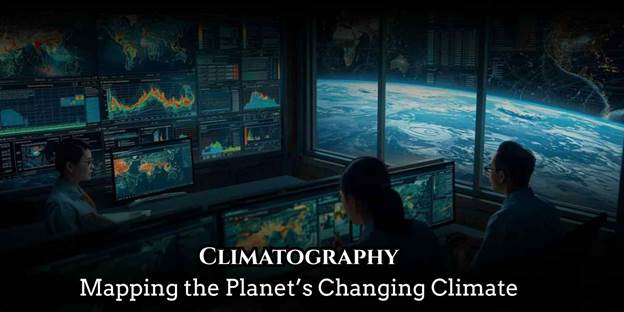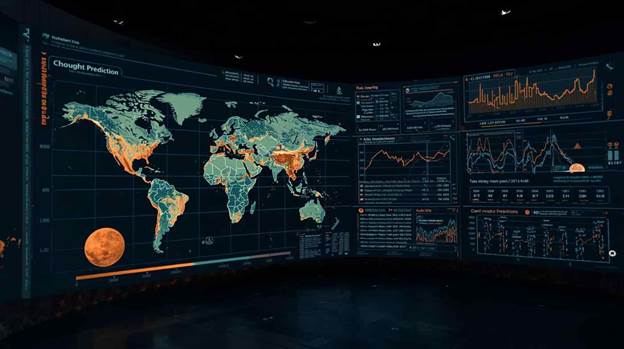In a world increasingly affected by environmental changes, Climatography stands as one of the most vital scientific tools for understanding how weather patterns shape life on Earth. From predicting droughts to mapping temperature shifts, Climatography helps scientists decode the rhythm of our planet’s atmosphere. This fascinating branch of climate science not only studies past and present climate data but also forecasts future trends that affect agriculture, biodiversity, and human livelihoods.
In this article, we’ll explore what Climatography is, its historical background, its growing importance, real-world applications, and how it empowers humanity to navigate the complexities of a changing climate.

What is Climatography?
At its core, Climatography is the detailed study and graphical representation of climate data over a specific region and time period. It involves collecting long-term weather records temperature, humidity, wind, and precipitation to create comprehensive climate maps and charts.
Unlike Meteorology, which focuses on short-term weather conditions, Climatography provides a broader and long-term perspective of climatic trends. Scientists rely on it to analyze patterns that reveal shifts in the planet’s temperature zones, rainfall distribution, and seasonal variations.
Key components of Climatography include:
• Temperature averages and anomalies
• Precipitation patterns and drought indices
• Humidity and air pressure trends
• Wind speed and direction data
By organizing these datasets, Climatography allows researchers to visualize how climates evolve and where critical changes occur.
A Brief History of Climatography
The roots of Climatography trace back to ancient civilizations that observed seasonal weather for agriculture. However, its scientific foundation was laid during the 19th century when systematic weather data collection began. The invention of instruments like the barometer and thermometer revolutionized climate observation.
In the 20th century, satellite technology and computer modeling transformed Climatography into a data-driven discipline. Modern climatologists now use global databases such as NOAA and NASA’s climate archives to compare decades of information.
This evolution from manual observation to digital mapping has made Climatography an indispensable part of modern environmental research.
The Importance of Climatography in Understanding Global Change
Climatography plays a critical role in understanding global warming, ecosystem health, and sustainable development. By examining temperature records, scientists can identify long-term warming trends and measure their impacts on ice caps, ocean levels, and ecosystems.
Key reasons why Climatography matters today:
• Predictive Insight: It helps forecast droughts, floods, and hurricanes with higher accuracy.
• Sustainability Planning: Governments use Climatography to design adaptive agricultural and urban strategies.
• Disaster Management: Data helps authorities prepare for extreme weather events and minimize loss.
• Global Awareness: It provides the public with scientific proof of ongoing climate transformations.
Without Climatography, understanding how human actions reshape the Earth’s climate would be nearly impossible.
Related article: The Role of Climatography in Environmental Sustainability: Using Data to Drive Climate Action
How Climatography Works: The Science Behind the Data
To produce reliable results, Climatography combines observational data, modeling, and visualization. Scientists collect information from weather stations, satellites, and ocean buoys to build long-term datasets.
Steps involved in climatographic research:
- Data Collection: Gathering historical weather data across decades.
- Data Processing: Removing anomalies and errors through statistical methods.
- Mapping and Visualization: Converting raw data into charts, heat maps, and graphs.
- Interpretation: Studying regional and global patterns to identify climatic shifts.
This meticulous approach allows Climatography to act as a “time machine” of climate science, connecting the dots between past conditions and future possibilities.
Real-World Applications of Climatography
Climatography has immense value across multiple industries and scientific domains:
• Agriculture: Farmers use climate maps to choose crops suited for their region’s weather patterns.
• Urban Planning: Architects and engineers rely on Climatography to design sustainable cities.
• Environmental Conservation: Organizations use climate data to protect endangered species and habitats.
• Energy Sector: Renewable energy developers use Climatography to optimize solar and wind installations.
For instance, African nations have applied climatographic data to combat drought through improved irrigation scheduling, while coastal regions in Asia use it to design flood-resistant infrastructure.

Challenges and Limitations of Climatography
Despite its significance, Climatography faces several challenges:
• Data Gaps: In developing regions, consistent long-term data collection is lacking.
• Technological Barriers: Advanced climate modeling requires expensive computing systems.
• Uncertainty in Predictions: Even with robust data, complex climate systems can produce unpredictable outcomes.
• Human Influence: Industrial emissions and deforestation rapidly alter climatic baselines, complicating climatographic projections.
Overcoming these challenges demands stronger global cooperation, data sharing, and public awareness of the importance of climate science.
The Future of Climatography: Mapping Tomorrow’s Climate
As climate change accelerates, the future of Climatography lies in artificial intelligence, machine learning, and big data analytics. These technologies enhance the accuracy of climate projections and enable faster response to environmental threats.
Emerging trends include:
• Real-time climate monitoring with AI sensors
• Predictive modeling for extreme weather events
• Integration with environmental policy-making
In the coming decades, Climatography will not only chart weather history but also guide global adaptation and sustainability strategies.
Conclusion
Climatography is more than just a scientific discipline it is humanity’s compass in navigating an uncertain climate future. By recording and interpreting long-term weather data, it empowers societies to prepare for challenges and protect ecosystems. As the planet’s climate continues to evolve, embracing the insights of Climatography will be essential for survival and sustainability. To truly understand our changing world, we must continue to explore, learn, and act upon the lessons revealed by this remarkable science.